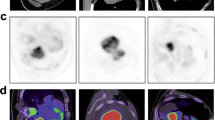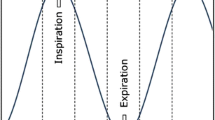Abstract
The aim of this study was to demonstrate the possibilities, advantages and limitations of virtual bronchoscopy using data sets from positron emission tomography (PET) and computed tomography (CT). Twelve consecutive patients with lung cancer underwent PET/CT. PET was performed with F-18-labelled 2-[fluorine-18]-fluoro-2-deoxy-D-glucose (18F-FDG). The tracheobronchial system was segmented with a volume-growing algorithm, using the CT data sets, and visualized with a shaded-surface rendering method. The primary tumours and the lymph node metastases were segmented for virtual CT-bronchoscopy using the CT data set and for virtual PET/CT-bronchoscopy using the PET/CT data set. Virtual CT-bronchoscopy using the low-dose or diagnostic CT facilitates the detection of anatomical/morphological structure changes of the tracheobronchial system. Virtual PET/CT-bronchoscopy was superior to virtual CT-bronchoscopy in the detection of lymph node metastases (P=0.001), because it uses the CT information and the molecular/metabolic information from PET. Virtual PET/CT-bronchoscopy with a transparent colour-coded shaded-surface rendering model is expected to improve the diagnostic accuracy of identification and characterization of malignancies, assessment of tumour staging, differentiation of viable tumour tissue from atelectases and scars, verification of infections, evaluation of therapeutic response and detection of an early stage of recurrence that is not detectable or is misjudged in comparison with virtual CT-bronchoscopy.

Similar content being viewed by others
References
Seemann MD, Seemann O, Dienemann H, Schalhorn A, Prime G, Fink U (1999) Diagnostic value of chest radiography, computed tomography and tumour markers in the differentiation of malignant from benign solitary pulmonary lesions. Eur J Med Res 4:313–327
Seemann MD, Seemann O, Luboldt W, Bonél H, Sittek H, Dienemann H, Staebler A (2000) Differentiation of malignant from benign solitary pulmonary lesions using chest radiography, spiral CT and HRCT. Lung Cancer 29:105–124
McAdams HP, Palmer SM, Erasmus JJ, Patz EF, Connolly JE, Goodman PC, Delong DM, Tapson VF (1998) Bronchial anastomic complications in lung transplant recipients: virtual bronchoscopy for noninvasive assessment. Radiology 209:689–695
Naidich DP, Harkin TJ (1995) Airways and lung: correlation of CT with fiberoptic bronchoscopy. Radiology 197:1–12
Seemann MD, Claussen CD (2001) Hybrid 3D visualization of the chest and virtual endoscopy of the tracheobronchial system: possibilities and limitations of clinical application. Lung Cancer 32:237–246
Seemann MD, Seemann O, Bonél H, Suckfüll M, Englmeier KH, Naumann A, Allen CM, Reiser MF (1999) Evaluation of the middle and inner ear structures: comparison of hybrid rendering, virtual endoscopy and axial 2D source images. Eur Radiol 9:1851–1858
Lee KS, Yoon JH, Kim TK, Kim JS, Chung MP, Kwon OJ (1997) Evaluation of tracheobronchial disease with helical CT with multiplanar and three-dimensional reconstruction: correlation with bronchoscopy. Radiographics 17:555–567
Englmeier KH, Haubner M, Lösch A, Eckstein F, Seemann MD, van Eimeren W, Reiser MF (1997) Hybrid rendering of multidimensional image data. Methods Inf Med 36:1–10
Seemann MD, Englmeier KH, Haubner M, Minx C, Luboldt W, Heuck A, Reiser MF (1998) Hybrid rendering of the cervico-cranial arteries using spiral computed tomography. Eur J Med Res 3:177–181
Seemann MD, Seemann O, Englmeier KH, Allen CM, Haubner M, Reiser MF (1998) Hybrid rendering and virtual endoscopy of the auditory and vestibular system. Eur J Med Res 3:515–522
Seemann MD, Seemann O, Luboldt W, Gebicke K, Prime G, Claussen CD (2000) Hybrid rendering of the chest and virtual bronchoscopy. Eur J Med Res 5:431–437
Seemann MD, Gebicke K, Luboldt W, Albes JM, Vollmar J, Schaefer JF, Beinert T, Englmeier KH, Bitzer M, Claussen CD (2001) Hybrid 3-D rendering of the thorax and surface-based virtual bronchoscopy in surgical and interventional therapy control. Fortschr Rontgenstr 173:650–657
Seemann MD (2004) PET/CT: fundamental principles. Eur J Med Res 9:241–246
Siegel BA, Dehdashti F (2005) Oncologic PET/CT: current status and controversies. Eur Radiol 15 [Suppl 4]:D127–132
Rosenbaum SJ, Lind T, Antoch G, Bockisch A (2006) False-positive FDG PET uptake—the role of PET/CT. Eur Radiol 16:1054–1065
Seemann MD (2005) Whole-body PET/MRI: the future in oncological imaging. Technol Cancer Res Treat 4:577–582
Seemann MD, Heuschmid M, Vollmar J, Kuettner A, Schober W, Schaefer JF, Bitzer M, Claussen CD (2003) Virtual bronchoscopy: comparison of different surface rendering models. Technol Cancer Res Treat 2:273–279
Pasic A, Brokx HA, Comans EF, Herder GJ, Risse EK, Hoekstra OS, Postmus PE, Sutedja TG (2005) Detection and staging of preinvasive lesions and occult lung cancer in the central airways with 18F-fluorodeoxyglucose positron emission tomography: a pilot study. Clin Cancer Res 11:6186–6189
Kamel EM, Zwahlen D, Wyss MT, Stumpe KD, von Schulthess GK, Steinert HC (2003) Whole-body (18)F-FDG PET improves the management of patients with small cell lung cancer. J Nucl Med 44:1911–1917
Marom EM, McAdams HP, Erasmus JJ, Goodman PC, Culhane DK, Coleman RE, Herndon JE, Patz EF Jr (1999) Staging non-small cell lung cancer with whole-body PET. Radiology 212:803–809
Bollen EC, Goei R, van’t Hof-Grootenboer BE, Versteege CW, Engelshove HA, Lamers RJ (1994) Interobserver variability and accuracy of computed tomographic assessment of nodal status in lung cancer. Ann Thorac Surg 58:158–162
Imdahl A, Jenkner S, Brink I, Nitzsche E, Stoelben E, Moser E, Hasse J (2001) Validation of FDG positron emission tomography for differentiation of unknown pulmonary lesions. Eur J Cardiothorac Surg 20:324–329
Van Haag DW, Follette DM, Roberts PF, Shelton D, Segel LD, Taylor TM (2002) Advantages of positron emission tomography over computed tomography in mediastinal staging of non-small cell lung cancer. J Surg Res 103:160–164
Goerres GW, Kamel E, Heidelberg TN, Schwitter MR, Burger C, von Schulthess GK (2002) PET-CT image co-registration in the thorax: influence of respiration. Eur J Nucl Med Mol Imaging 29:351–360
Goerres GW, Kamel E, Seifert B, Burger C, Buck A, Hany TF, von Schulthess GK (2002) Accuracy of image coregistration of pulmonary lesions in patients with non-small cell lung cancer using an integrated PET/CT system. J Nucl Med 43:1469–1475
Osman MM, Cohade C, Nakamoto Y, Wahl RL (2003) Respiratory motion artifacts on PET emission images obtained using CT attenuation correction on PET-CT. Eur J Nucl Med Mol Imaging 30:603–606
De Juan R, Seifert B, Berthold T, von Schulthess GK, Goerres GW (2004) Clinical evaluation of a breathing protocol for PET/CT. Eur Radiol 14:1118–1123
Seemann MD (2004) Human PET/CT scanners: feasibility for oncological in vivo imaging in mice. Eur J Med Res 9:468–472
Fleiter T, Merkle EM, Aschoff AJ, Lang G, Stein M, Görich J, Liewald F, Rilinger N, Sokiranski R (1997) Comparison of real-time virtual and fiberoptic bronchoscopy in patients with bronchial carcinomas: opportunities and limitations. AJR Am J Roentgenol 169:1591–1595
Author information
Authors and Affiliations
Corresponding author
Rights and permissions
About this article
Cite this article
Seemann, M.D., Schaefer, J.F. & Englmeier, KH. Virtual positron emission tomography/computed tomography-bronchoscopy: possibilities, advantages and limitations of clinical application. Eur Radiol 17, 709–715 (2007). https://doi.org/10.1007/s00330-006-0350-y
Received:
Revised:
Accepted:
Published:
Issue Date:
DOI: https://doi.org/10.1007/s00330-006-0350-y




